Today’s teachers are encouraged to design student-centered learning experiences that support 21st-century teaching and learning. There is less emphasis on lessons that focus on the recall of basic facts and concepts, and more emphasis on the “4 C’s”: Critical Thinking, Creativity, Collaboration, and Communication. Teachers are expected to develop lesson plans that challenge students to study topics in-depth, following frameworks that foster higher-level thinking skills, such as Webb’s Depth of Knowledge (DOK), and at the same time effectively integrate the use of technology into daily teaching and learning activities.
To get a better understanding, let’s take a look at some key shifts occurring in education regarding teachers, students, and technology:
Shifts in teacher-student roles:
- The teacher functions as a learning catalyst/facilitator and a lead learner, rather than “sage on the stage”.
- There is less focus on strategies such as lecture-discussions, passive reading and notetaking, and worksheet assignments (paper as well as digital).
- More emphasis is placed on exploring concepts deeply – depth over breadth, with students taking the lead.
- There is more focus on creative group work that involves cooperative and collaborative learning activities. More time is allocated project and problem-based learning in which students explore topics in-depth.
Shifts in the use of technology:
- Teacher and students learn and explore technology and digital resources together.
- Teachers and students use technology in innovative, creative ways.
- More emphasis on the integration of technology that enables students to explore concepts deeply, in multiple ways. This includes the use of online resources, study of primary sources, and the creative use of educational multimedia and videos.
- More emphasis on the creative use of technology by students to communicate with others, through interactive presentations, digital storytelling, and designing learning experiences for others outside the walls of the classroom, individually and in groups.
- Less emphasis on skill/drill “electronic workbook” applications.
There are a number of frameworks that serve as useful guides for teachers who are looking to implement instructional units and lessons that foster the 4Cs, depth of knowledge, and higher level thinking skills. Here are a few:
Webb’s Levels of Content Complexity/Depth of Knowledge (DOK)
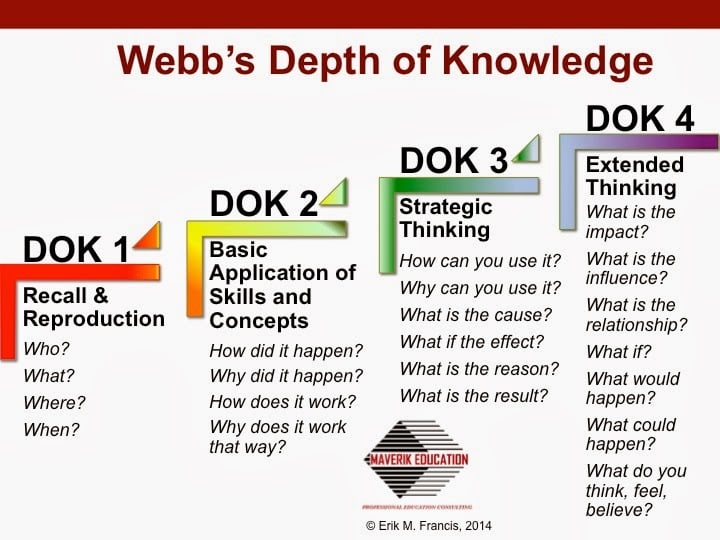
Webb’s Depth of Knowledge (DOK) is a 4-level scale that is used to describe the content complexity of learning expectations, instructional materials and assessment items. In many states, curriculum standards are assigned a DOK level.
- Recall/Reproduction – Recall a fact, information, or procedure; process information on a low level
- Skill/Concept – Use information or conceptual knowledge, two or more steps
- Strategic Thinking – Requires reasoning, developing a plan or a sequence of steps, more than one reasonable approach
- Extended Thinking – Requires connections and extensions, high cognitive demands and complex reasoning
Revised Bloom’s Taxonomy (Anderson and Krathwohl)
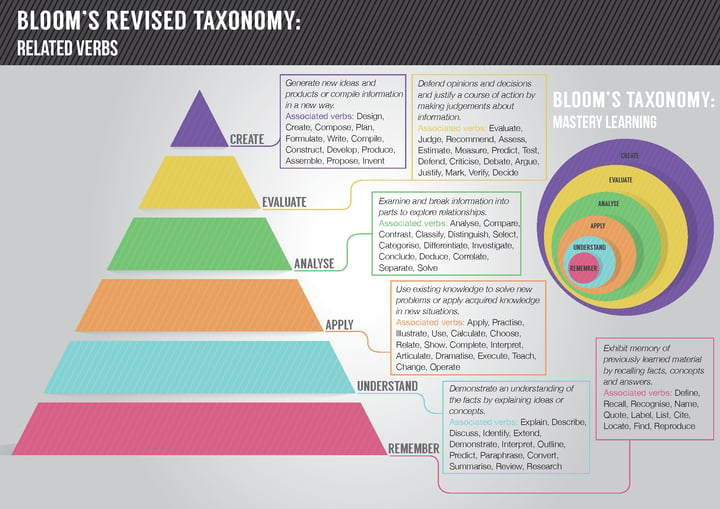
Benjamin Bloom, an educational psychologist, developed his taxonomy of educational objectives in the 1950s to provide educators a framework to use when developing objectives for lesson plans that foster cognitive complexity. Bloom’s taxonomy was revised in 2001 by David R. Krathwohl, Lorin W. Anderson, and their colleagues. From this perspective, learning objectives that support creativity are viewed as higher order thinking skills.
Remember
Understand
Apply
Analyze
Evaluate
Create
Hess’s Cognitive Rigor Matrix
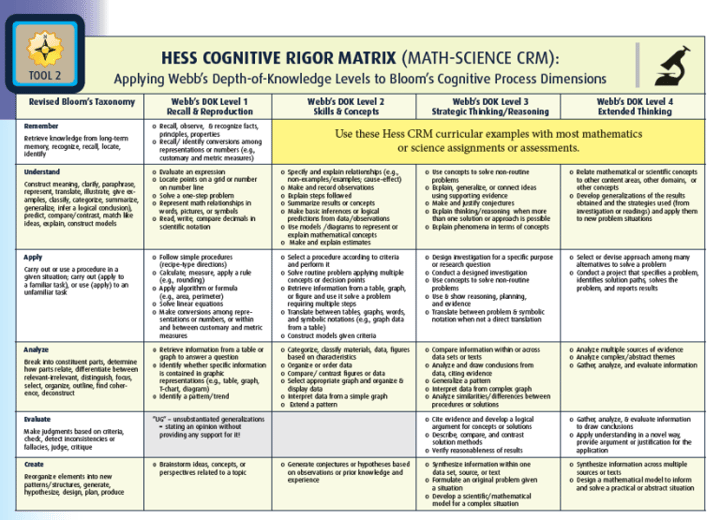
Karin Hess’s Cognitive Rigor Matrix combines Bloom’s Revised Taxonomy with Webb’s DOK model. Hess has developed cognitive rigor matrices across content areas, all with specific descriptors.
Marzano’s Taxonomy
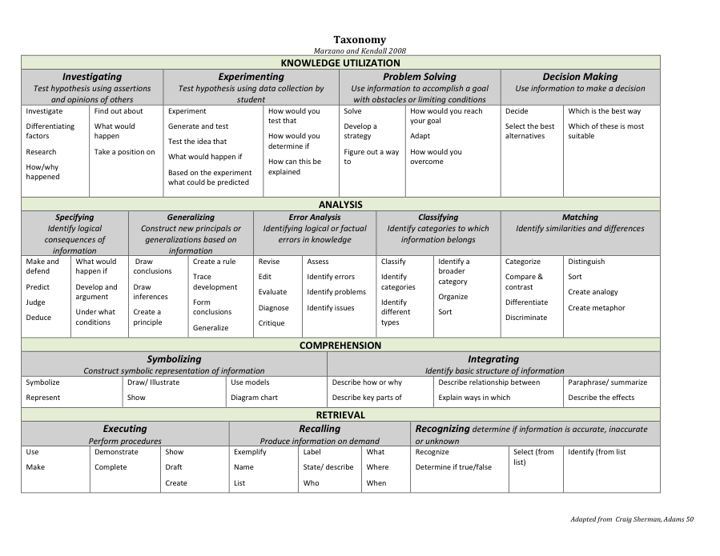
Robert J. Marzano’s taxonomy includes many of the concepts behind Webb’s DOK, Bloom’s Revised Taxonomy, and Hess’s Cognitive Rigor Matrix:
- Retrieval -- Activation and transfer of knowledge from permanent memory to working memory |Recognizing, Recalling, Executing
- Comprehension -- Identification of the critical or defining attributes of knowledge. Integrating, Symbolizing, Matching, Classifying
- Analysis -- Reasoned extensions of knowledge and generation of new information not already processed | Analyzing Errors, Generalizing, Specifying
- Knowledge Utilization -- Application or use of knowledge to accomplish a specific task | Decision-making, Problem-solving, Experimenting, Investigating
How can teachers use Snowflake MultiTeach and Lessons Online to support higher-order thinking skills and DOK?
If you are new to Snowflake MultiTeach and Lessons Online, and would like to create learning experiences that engage and challenge your students, first take some time to assess how you currently use technology with students to support in-depth learning and 21st century-related skills. This will help you as you develop unit and lesson plans that integrate the Snowflake MultiTeach active learning ecosystem.
Do this with a peer if you can!
- If you have been using an interactive whiteboard or projection system, think about how you use it to support the curriculum. Do you use the system for teacher-led presentations only, or do you encourage your students to interact with content during learning activities? Do you use the system as a learning station? Do your students use the system to give presentations and share their digital creations with the class?
- If you have a 1:1 classroom, what technology-supported resources do you use to support communication, collaboration, critical thinking, and creativity? What sorts of technology-supported activities do your students enjoy?
- What online subscriptions are available to you within your school district? Do you utilize educational video resources from YouTube, Teacher Tube, or TEDEd or other sources? To what extent do you use them? How do you assess your students’ learning from these resources?
- What sort of ways do your students use technology in creative ways? Do they create podcasts? Do they use video for digital storytelling? Do they incorporate digital multimedia in their presentations?
- What percentage of time do you plan for your students to engage in depth-of-knowledge, and 4 C’s related learning activities?
Next, take some time to explore the various features of Snowflake MultiTeach and Lessons Online and jot down your ideas for use with your students. Think about ways you can utilize these features to support your curriculum and technology integration goals and learning experiences you’d like to explore in the future.
So how does Snowflake MultiTeach support 21st-century skills and DOK?
The examples below were created using various Tools apps in Snowflake MultiTeach. The learning activities are anchored by engaging educational videos that were selected to get students thinking and analyzing information in a fun way.
The YouTube Linked Lessons were created with the Lessons App in Snowflake MultiTeach or Lessons Online and are located in the MultiTeach Lessons Community. The descriptions include links to the videos, curriculum standards, and links to related online resources.
In the following screenshots, the Zones feature is used to highlight ways that Snowflake MultiTeach presents information simultaneously. Tapping on an icon in the side menu of an application or lesson in an individual zone will open it in full-screen mode, and tapping it again will return it to the zone. The zones configuration can be saved for later use.
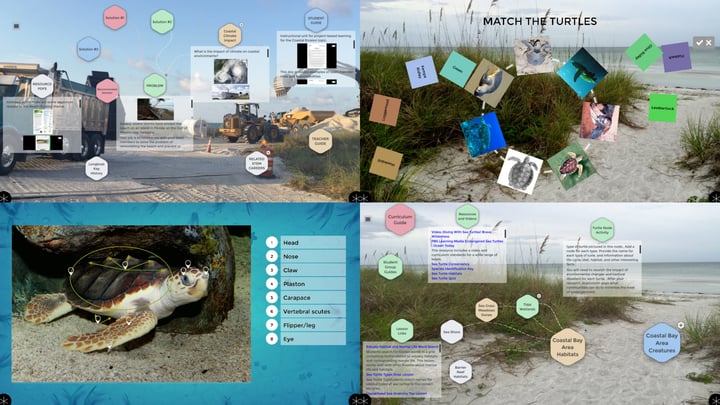
In the above screenshot, two Nodes projects are featured that go along with a number of related lessons. The top left zone displays a Nodes project about coastal erosion. The lower right zone displays a Nodes project about coastal animals and their habitats. Both provide students with a series of group activities designed for use over a period of several sessions, and include a number of higher-level, problem-solving challenges. The remaining zones feature lessons created to go along with the coastal theme and serve as discussion-starters for students working in pairs or small groups.
The screenshot below features Nodes project designed for an interdisciplinary multi-session unit about farms, science related to farms and agriculture, and literature where a farm plays a role. The lessons on the right side of the screen are linked to a YouTube video from Storyline Online of “The Tale of Peter Rabbit”, which is also linked within the Nodes project.
The top right lesson consists of a few higher-level questions about the story. In the bottom right zone, the students discuss the events and characters of the story as they arrange pictures to follow the story’s sequence of events. The lesson requires the students to match animals to babies and discuss if the animals were featured in the story.
The farm theme can be extended for use by older students by incorporating links and resources suitable for the upper grades. Lessons can be selected or created for topics related to agriculture, botany, agribusiness, and so forth.
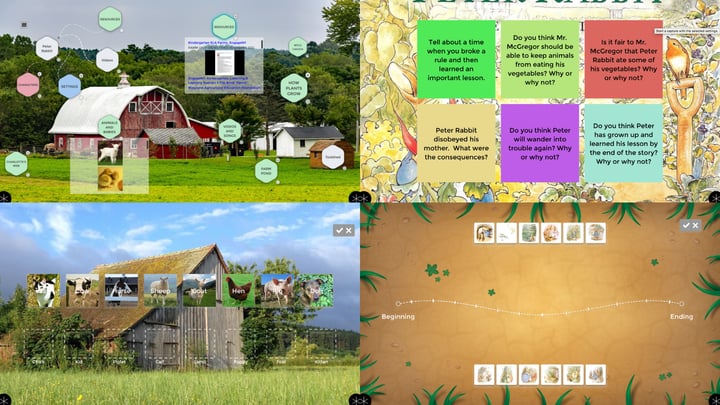
The following screenshot features a Nodes project with a physics theme, focusing on Newton laws. The project, like the others, was designed as a multi-session instructional unit that focuses on group work. There are links to physics-related videos about skateboards, fidget spinners, as well as instructional videos. The project can be used with other Snowflake MultiTeach apps.
In the screenshot below, the YouTube video about the physics of space battles is featured in the top right zone. Students watch the video and then discuss what they’ve learned using the Spinner lesson. In the lower-left zone, students can discuss each scientist and their contribution to the field of physics as they move their pictures to corresponding placeholders.
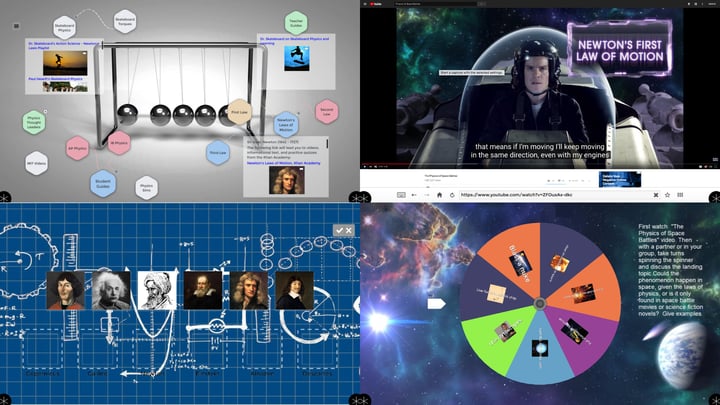
Incorporate Video!
All of the examples discussed in this post incorporate the use of engaging videos. Why is this important?
Many students spend time outside of school accessing engaging educational videos online. They watch videos to learn more about topics that interest them, to review information they didn’t quite understand in class-- and sometimes simply to be entertained. Videos engage students and often motivate them to learn more.
However, most of these videos don’t come with activities to encourage critical thinking skills or DOK.
To address this issue, Snowflake MultiTeach + Lessons Online learning ecosystem provides many ways to incorporate videos to support depth-of-knowledge and critical thinking skills, and at the same time, provides teachers a chance to provide structure and guidance to their students as needed:
- Within Snowflake MultiTeach, online videos can be searched for and accessed through the YouTube app, linked in the Media or Nodes app, or bookmarked in the Browser app for easy access.
- The MultiTeach Lessons Community has a wide range of lessons created specifically to go along with educational videos from YouTube. The videos can be found by using the keyword YTLL (YouTube Linked Lessons) in the search box in the Lessons App in Snowflake MultiTeach or on the My Lessons page in Lessons Online. Teachers can set some of the lesson types to be gradable so they can assess progress. Using Lessons Online, the lessons can be sent to the students to complete as they watch the videos, at home, or within the classroom.
- Teachers and students can create lessons to go along with online videos or their own videos.
- Lessons can be created with the Snowflake MultiTeach Lessons App or Lessons Online that can support depth-of-knowledge across other media formats. For example, a Spinner, Cards, or Sentences template can be used by the teacher or students that incorporates questions regarding the accuracy, perspective, credibility, and relevance of information, video, multimedia, data, or other resources related to the themes of the projects the students are working on.
- Along with the lessons, the various Tools apps in Snowflake MultiTeach can be used to support 21st-century learning and DOK. For example, the Nodes app has multiple functions and can be used for concept mapping, webquest activities, and student group presentation planning and delivery.
- The various Snowflake MultiTeach Tools apps are good for storing rubrics, student cooperative group guidelines, and related information to support depth-of-knowledge and the 4 C’s. For example, in the Nodes app, a node can be designated as a student guide to store or link rubrics and documents for close reading activities. Rubrics and other documents can also be inserted in the Media app or accessed through the Google Docs tool.
If you’d like to learn more about 21st-century learning, depth-of-knowledge, technology + curriculum integration, explore some of the resources below.
Want to try Snowflake MultiTeach? Download the 60-day FREE trial today by clicking the button below:
Resources
Karin Hess
Hess’ Cognitive Rigor Matrix & Curricular Examples: Applying Webb’s Depth-of-Knowledge Levels to Bloom’s Cognitive Processes Dimensions (ELA example, pdf)
A Guide for Using Webb’s Depth of Knowledge with Common Core State Standards
Cognitive Rigor and Depth of Knowledge
Project Based Learning Resources (Includes rubrics and planning guides for student groups)
Norman L. Webb
Depth-of-Knowledge Levels for Four Content Areas (pdf)
Bloom’s Revised Taxonomy
Krathwohl, D. R. (2002) A Revision of Bloom’s Taxonomy. (PDF) Theory into Practice. V 41. #4. Autumn, 2002. Ohio State University
Tami Hicks/Karin Hess
Digital Resources that Support DOK and Rigor in the Classroom (pdf)
Thoughtful Learning
What are learning skills? (21st Century 4 C’s)
Boston College Libraries
Technology Tools for Lesson Plans: Bloom’s Taxonomy & Technology Integration
Robert J. Marzano/Learning Sciences International
Marzano Taxonomy -- Terms and Phrases, Question Stems, Products (pdf)
Creative Educator
Creative Instructional Design and Cognitive Complexity
Common Core State Standards Initiative
Framework for 21st Century Learning
Edutopia (Gerald Aungst)
Using Webb’s Depth of Knowledge to Increase Rigor
NUITEQ
Collaborative Technology Integration with Snowflake MultiTeach

 3-in-1 Mic
3-in-1 Mic



